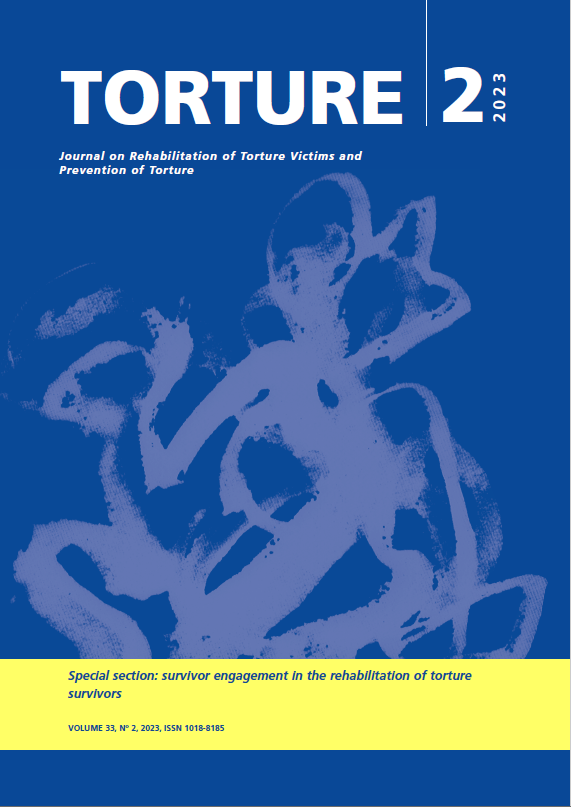Medico-legal evaluation of torture victims in the USA before the Istanbul Protocol
DOI:
https://doi.org/10.7146/torture.v33i2.135388Palabras clave:
Torture, Istanbul protocol, Affidavit, Inter-American Court of Human RightsResumen
The article reviews the historical precedents of the Forensic Assessment of Torture Survivors in the US in the 1970s and 1980s, setting the precedents of the US branch of the construction of the Istanbul Protocol that was developed in the late 1990s. It includes, as supplementary material, the first model of affidavit developed in Los Angeles at that time, which is the first predecessor in the history of the Istanbul Protocol in the US. Similar models were developed in Latin America, Canada and Turkey. All these efforts were later joined under the United Nations auspices in what finally ended to be the Istanbul Protocol.
Citas
Allodi F, (Canadian Study) Randall G, Lutz E, Quiroga J, Zunzunegui M. V, Kolff C, Deutsch A, Doan R, (US Study) In Ed. Stover E, Nightingale E, (1985) The breaking of bodies and Mind. Torture, psychiatric abuse, and the health professionals. AAAS W.H. Freeman and Company N.Y.
Amnesty International (1974) Chile and Amnesty International report. Page 1-80. Amnesty International Publication, London
Amnesty International (1975) Report on Torture. Farrar, Straus, and Giroux editors, New York
Claude, R P. (1985) Torture on trial: The case of Joelito Filartica and the Clinic of Hope page: 79-100 chapter 4. In Eric Stover and Nightingale, E. The breaking bodies and minds. W.H.Freeman and Company New York
Kinzie JD, (1972) Cross-cultural psychotherapy. An open System model. Am J. Psychotherapy 26:220-231
Kinzie JD, Kiet AT, Breckenridge A, Bloom JD. (1980) An Indochinese refugee psychiatric clinic: culturally accepted treatment approaches. Am J Psychiatry 137;11:1429-1432
Kinzie JD, (1985) Cultural aspect of psychiatric treatment with Indochinese refugees. Am J. Social Psychiatry 5;1:47-53
Kornbluh, P. (2003) The Pinochet file. A national security archives book. The New Press New York. NY
Netherland Ministry of Welfare health and culture affairs and WHO regional office of Europe. (1987) Health hazards of organized violence: proceedings of a working group. April 1986 Publication 1987.
Quiroga J, Deustch A, O‘Grady K, et al (1981) Medical and psychological sequelae in Latin American survivors of torture. Presented at the Symposium on research practice in treatment and rehabilitation of torture, terrorism, and hostage taken. APA meeting Los Angeles May
Quiroga J, Lira E. (2022) The military coup in Chile in 1973, the immediate reaction of international organizations, and the founding of the first rehabilitation program for torture victims in 1977. Torture 32(1-2):113-132
United Nations. Convention against torture and other cruel, inhuman or degrading treatment or punishment. 10 December 1984. In: Human rights 1945-1995. Published by United Nations. Blue Book Serie. Volume VII: Document 50. 1995:294-300.
Weathers, F. W., Litz, B., Herman, D., Juska, J., & Keane, T. (1993). PTSD Checklist—Civilian Version (PCL-C) [Database record]. APA PsycTests. https://doi.org/10.1037/t02622-000
World Medical Association (WMA), Declaration of Tokyo. (1975)

Descargas
Publicado
Cómo citar
Número
Sección
Licencia
Derechos de autor 2023 Torture Journal

Esta obra está bajo una licencia internacional Creative Commons Atribución-NoComercial-SinDerivadas 4.0.
We accept that some authors (e.g. government employees in some countries) are unable to transfer copyright. The Creative Commons Licence Attribution-NonCommercial-NoDerivatives 4.0 International (CC BY-NC-ND 4.0) covers both the Torture Journal and the IRCT web site. The publisher will not put any limitation on the personal freedom of the author to use material contained in the paper in other works which may be published, provided that acknowledgement is made to the original place of publication.

